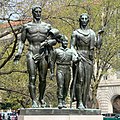Modern Art Foundry
 Modern art foundry logo | |
| Industry | Foundry |
|---|---|
| Founded | 1932 |
| Founder | John Spring [1] |
| Headquarters | 18-70 41st Street Astoria, New York 11105, United States |
Key people | Jeffrey Spring, President[2] |
| Website | www |
The Modern Art Foundry is an historic foundry in Astoria, Queens, New York, founded in 1932 by John Spring. His descendants continue to operate the business[3] in what used to be the carriage house of the Steinway Mansion.[2]
Modern Art Foundry specializes in working with artists who create limited edition works, usually intended for museums and galleries.[4] The foundry utilizes the lost-wax casting method for producing its large-scale work.[3] It also does maintenance and conservation of existing works.[5]
History
[edit]John Spring, a Polish immigrant, started his business in 1932 on Astoria Boulevard, at the end near what is now the Socrates Sculpture Park.[4] In 1947, the foundry moved from its location near the East River to where it is at present.[2] Spring built the business on close relationships with a small group of "prominent and prolific" artists. Among the artists who have worked there are Jose de Creeft, Jacques Lipchitz, Louise Bourgeois,[3] Gaston Lachaise, Joan Miró, Alexander Archipenko, and Isamu Noguchi.[6]
Operations
[edit]In contrast to most foundries that have switched over to ceramic shell casting, Modern Art utilizes the lost-wax casting method for producing its large-scale work.[3] Workers first create a wax copy of the artist's original model and then apply a plastic coating to it. The mold is then fired in a kiln, which causes the wax to melt away. Molten bronze is then poured into the mold. This method yields an exact bronze replica of the artist's original model.[3]
The foundry is known for its exacting and innovative work. Bourgeois chose the foundry to cast the Maman sculpture because of its reputation and output.[3] In the early 1960s, Jasper Johns cast "Light Bulb," "Flashlight; Painted Bronze (ale cans)", "Painted Bronze (paintbrushes)", "Flag", and "Bronze (Light Bulb, Socket, Wire on Grid" at the foundry.[7]
In 2002, artisans at the foundry replaced the original zinc statues that were part of the 1867 Civil War Soldiers Monument in the Green-Wood Cemetery, Brooklyn, with bronze replicas.[8]
Gallery
[edit]-
Hans Christian Andersen, by Georg John Lober, located in Central Park
-
Maman by Bourgeois
-
Sophocles in Athens Square Park[9]
-
Garment Worker by Judith Weller[4]
-
Soldier's Monument at Green-Wood Cemetery
References
[edit]- ^ Jeffrey Spring. "About". Modern Art Foundry. Retrieved January 26, 2007.
- ^ a b c Mukhi, Karun (November 14, 2016). "The Modern Art Foundry, A Jewel Hidden in Plain Sight in the Steinway Mansion Carriage House". Retrieved August 15, 2019.
- ^ a b c d e f Anderson, Nicole Gates (September 6, 2012). "Where Bronze Transforms Into Fine Art". The New York Times.
- ^ a b c Evelly, Jeanmarie (May 19, 2017). "See Inside The 85-Year-Old Astoria Foundry Where Famous Sculptures Get Made". Astoria & Long Island City. DNAinfo. Archived from the original on November 18, 2017. Retrieved May 19, 2017.
- ^ "Modern Art Foundry". JebusandAndrea. May 27, 2017.
- ^ Freudenheim, Ellen (2013). Queens What to Do, Where to Go (and How Not to Get Lost) in New York's Undiscovered Borough. St. Martin's Publishing Group. p. 38. ISBN 9781466852389.
- ^ Leggio, James; Weiley, Susan (1991). John Elderfield (ed.). American Art of the 1960s. New York: Museum of Modern Art. p. 62. ISBN 9780870704581.
- ^ "Modern Art Foundry Recreates Civil War Statue". Queens Scene Magazine. August 15, 2019.
- ^ Evelly, Jeanmarie (March 18, 2015). "7-Foot Sophocles is Final Piece in Astoria Park Greek Statues Collection". Astoria & Long Island City. DNAinfo. Archived from the original on August 28, 2019. Retrieved March 18, 2015.
External links
[edit] Media related to Modern Art Foundry at Wikimedia Commons
Media related to Modern Art Foundry at Wikimedia Commons- "Modern Art Foundry". Made in NYC. Retrieved May 4, 2005.
- Modern Art Foundry's channel on YouTube
- Richman, Jeff (October 8, 2015). "Another Mystery Solved". The Green-Wood Historic Fund.







![Sophocles in Athens Square Park[9]](http://upload.wikimedia.org/wikipedia/commons/thumb/f/fa/Athens_Square_Park_Qns_td_%282019-08-21%29_25_-_Sophocles.jpg/80px-Athens_Square_Park_Qns_td_%282019-08-21%29_25_-_Sophocles.jpg)
![Garment Worker by Judith Weller[4]](http://upload.wikimedia.org/wikipedia/commons/thumb/2/24/Street_statue_of_a_garment_worker_on_Seventh_Avenue_in_Manhattan_in_the_heart_of_New_York_City%27s_Garment_District_LCCN2011632581.tif/lossy-page1-120px-Street_statue_of_a_garment_worker_on_Seventh_Avenue_in_Manhattan_in_the_heart_of_New_York_City%27s_Garment_District_LCCN2011632581.tif.jpg)
